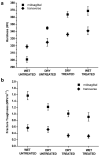Compositional determinants of mechanical properties of enamel
- PMID: 18573984
- PMCID: PMC2658820
- DOI: 10.1177/154405910808700711
Compositional determinants of mechanical properties of enamel
Abstract
Dental enamel is comprised primarily of carbonated apatite, with less than 1% w/w organic matter and 4-5% w/w water. To determine the influence of each component on the microhardness and fracture toughness of rat incisor enamel, we mechanically tested specimens in which water and organic matrix were selectively removed. Tests were performed in mid-sagittal and transverse orientations to assess the effect of the structural organization on enamel micromechanical properties. While removal of organic matrix resulted in up to a 23% increase in microhardness, and as much as a 46% decrease in fracture toughness, water had a significantly lesser effect on these properties. Moreover, removal of organic matrix dramatically weakened the dentino-enamel junction (DEJ). Analysis of our data also showed that the structural organization of enamel affects its micromechanical properties. We anticipate that these findings will help guide the development of bio-inspired nanostructured materials for mineralized tissue repair and regeneration.
Figures



Similar articles
-
Controlled failure mechanisms toughen the dentino-enamel junction zone.J Prosthet Dent. 2005 Oct;94(4):330-5. doi: 10.1016/j.prosdent.2005.08.013. J Prosthet Dent. 2005. PMID: 16198169
-
Indentation damage and mechanical properties of human enamel and dentin.J Dent Res. 1998 Mar;77(3):472-80. doi: 10.1177/00220345980770030601. J Dent Res. 1998. PMID: 9496920
-
Fatigue crack propagation path across the dentinoenamel junction complex in human teeth.J Biomed Mater Res A. 2003 Jul 1;66(1):103-9. doi: 10.1002/jbm.a.10541. J Biomed Mater Res A. 2003. PMID: 12833436
-
The wear and tear of teeth.Med Princ Pract. 2015;24 Suppl 1(Suppl 1):3-13. doi: 10.1159/000367976. Epub 2014 Nov 21. Med Princ Pract. 2015. PMID: 25427777 Free PMC article. Review.
-
Nature's design solutions in dental enamel: Uniting high strength and extreme damage resistance.Acta Biomater. 2020 Apr 15;107:1-24. doi: 10.1016/j.actbio.2020.02.019. Epub 2020 Feb 19. Acta Biomater. 2020. PMID: 32087326 Review.
Cited by
-
Mapping residual organics and carbonate at grain boundaries and the amorphous interphase in mouse incisor enamel.Front Physiol. 2015 Mar 19;6:57. doi: 10.3389/fphys.2015.00057. eCollection 2015. Front Physiol. 2015. PMID: 25852562 Free PMC article.
-
Materials engineering by ameloblasts.J Dent Res. 2015 Jun;94(6):759-67. doi: 10.1177/0022034515577963. Epub 2015 Mar 23. J Dent Res. 2015. PMID: 25800708 Free PMC article. Review.
-
A portable fiber-optic raman spectrometer concept for evaluation of mineral content within enamel tissue.J Clin Exp Dent. 2017 Feb 1;9(2):e238-e241. doi: 10.4317/jced.53185. eCollection 2017 Feb. J Clin Exp Dent. 2017. PMID: 28210442 Free PMC article.
-
Reliability and failure modes of implant-supported zirconium-oxide fixed dental prostheses related to veneering techniques.J Dent. 2011 Jul;39(7):489-98. doi: 10.1016/j.jdent.2011.04.006. Epub 2011 Apr 28. J Dent. 2011. PMID: 21557985 Free PMC article.
-
Enamel Anomalies in a Pachyonychia Congenita Patient with a Mutation in KRT16.J Invest Dermatol. 2019 Jan;139(1):238-241. doi: 10.1016/j.jid.2018.07.005. Epub 2018 Sep 25. J Invest Dermatol. 2019. PMID: 30009827 Free PMC article. No abstract available.
References
-
- Anstis GR, Chantikul P, Lawn BR, Marshall DB. A critical evaluation of indentation techniques for measuring fracture toughness: I. Direct crack measurements. J Am Ceram Soc. 1981;64:533–538.
-
- ASTM . Standard test method for microhardness of materials. American Society for Testing and Materials; Philadelphia: 1991. ASTM designation E 384.
-
- Belcourt A, Gillmeth S. EDTA soluble-protein of human mature normal enamel. Calcif Tissue Int. 1979;28:227–231. - PubMed
-
- Broz JJ, Simske SJ, Corley WD, Greenberg AR. Effects of deproteinization and ashing on site-specific properties of cortical bone. J Mater Sci: Mater Med. 1997;8:395–401. - PubMed
-
- Cuy JL, Mann AB, Livi KJ, Teaford MF, Weihs TP. Nanoindentation mapping of the mechanical properties of human molar tooth enamel. Arch Oral Biol. 2002;47:281–291. - PubMed
Publication types
MeSH terms
Substances
Grants and funding
LinkOut - more resources
Full Text Sources

